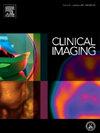Subdural collections in the neonatal ICU: Assessment using high frequency sonography
IF 1.5
4区 医学
Q3 RADIOLOGY, NUCLEAR MEDICINE & MEDICAL IMAGING
引用次数: 0
Abstract
Background
Subdural collections (SDC) in the neonate are most often diagnosed on CT and MR as birth related subdural hematoma. With the use of high frequency linear ultrasound (US) transducers, SDC have been seen with increased frequency by US in our NICU population.
Objective
The aim is to determine the prevalence of SDC on US in our NICU population and to assess whether changes in US transducer frequency effects detection.
Materials/methods
A retrospective review was conducted of head US in our NICU between August 2020 and March 2021. All scans were done using the anterior fontanelle approach. Included exams had cine clips with 1) full brain field of view (FOV) with linear 2–9 MHz transducer, and 2) superficial FOV with either linear 2–9 or 6–24 MHz transducer. Images were assessed for presence of SDC and if present echogenicity of the SDC relative to the subarachnoid fluid.
Results
142 US exams met inclusion criteria. SDC were identified in 10 patients, on 15 studies. For patients with SDC, median gestational age at birth was 31.3 weeks (versus 34.4 weeks in patients without SDC). SDC were only identified on superficial FOV cine clips performed with the 6–24 MHz transducer, and all were anechoic. Earlier gestational age and thrombocytopenia were associated with SDC.
Conclusion
Small anechoic subdural collections can be visualized in head US exams in NICU patients; however, their detection is highly dependent on the use of very high frequency linear transducer with small FOV imaging.
新生儿ICU的硬膜下积液:高频超声评估
背景:新生儿硬膜下积液(SDC)在CT和MR上最常被诊断为与出生相关的硬膜下血肿。随着高频线性超声(US)换能器的使用,在我们的新生儿重症监护病房人群中,US发现SDC的频率越来越高。目的确定新生儿重症监护病房人群中US的SDC患病率,并评估US换能器频率的变化是否影响检测。材料/方法对2020年8月至2021年3月我院新生儿重症监护病房头部US进行回顾性分析。所有扫描均采用前囟门入路。纳入的检查包括电影剪辑,1)全脑视场(FOV)与线性2 - 9 MHz换能器,2)浅表视场与线性2 - 9或6-24 MHz换能器。评估图像是否存在SDC,以及是否存在SDC相对于蛛网膜下腔液的回声性。结果142项美国检查符合纳入标准。在15项研究中,在10例患者中发现了SDC。对于SDC患者,出生时中位胎龄为31.3周(非SDC患者为34.4周)。SDC仅在使用6-24 MHz换能器进行的浅视场电影片段上被识别出来,并且都是消声的。早孕龄和血小板减少与SDC有关。结论新生儿重症监护病房(NICU)患者头部超声检查可观察到小的无回声硬膜下积液;然而,它们的检测高度依赖于使用高频线性换能器与小视场成像。
本文章由计算机程序翻译,如有差异,请以英文原文为准。
求助全文
约1分钟内获得全文
求助全文
来源期刊

Clinical Imaging
医学-核医学
CiteScore
4.60
自引率
0.00%
发文量
265
审稿时长
35 days
期刊介绍:
The mission of Clinical Imaging is to publish, in a timely manner, the very best radiology research from the United States and around the world with special attention to the impact of medical imaging on patient care. The journal''s publications cover all imaging modalities, radiology issues related to patients, policy and practice improvements, and clinically-oriented imaging physics and informatics. The journal is a valuable resource for practicing radiologists, radiologists-in-training and other clinicians with an interest in imaging. Papers are carefully peer-reviewed and selected by our experienced subject editors who are leading experts spanning the range of imaging sub-specialties, which include:
-Body Imaging-
Breast Imaging-
Cardiothoracic Imaging-
Imaging Physics and Informatics-
Molecular Imaging and Nuclear Medicine-
Musculoskeletal and Emergency Imaging-
Neuroradiology-
Practice, Policy & Education-
Pediatric Imaging-
Vascular and Interventional Radiology
 求助内容:
求助内容: 应助结果提醒方式:
应助结果提醒方式:


